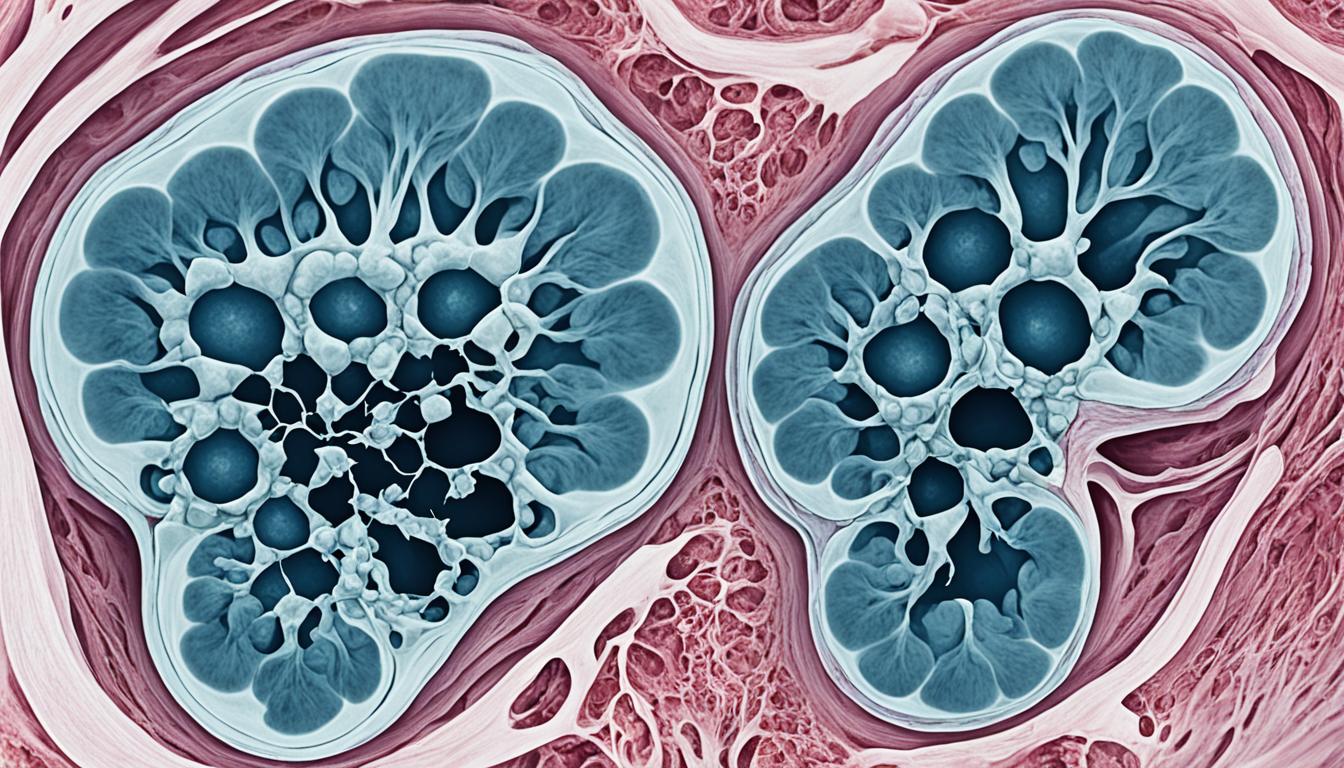A molar pregnancy is a rare issue where a tumor grows in the uterus. It happens instead of a regular pregnancy. This can lead to losing the pregnancy, often as a miscarriage. The cause lies in genetic issues at conception.
There are two kinds: partial and complete. A partial molar pregnancy sees both the placenta and embryo being abnormal. This is usually because two sperm fertilized the egg. A complete molar pregnancy happens with an abnormal placenta but no embryo. It’s from an egg fertilized without genetic content.
Signs of a molar pregnancy are vaginal bleeding and a watery discharge. You might also see grape-like sacs, feel sick, vomit, have pelvic pain, and your pregnancy hormone could be very high. Doctors can find molar pregnancies using ultrasound and blood tests for hCG.
The main treatment is removing the abnormal tissue. This can be done with a D&C procedure or meds to make the uterus push out the tissue. Sometimes, removing the uterus might be needed.
Key Takeaways:
- Molar pregnancies are rare but serious issues in pregnancy.
- They are caused by genetic issues at conception.
- There are two types – partial and complete.
- Signs include bleeding, unusual discharge, and high hCG levels.
- Diagnosis uses ultrasound and blood tests.
- The main treatment is removing the abnormal tissue. Stem cell therapy is being looked into.
Causes of Molar Pregnancy
The cause of molar pregnancies isn’t fully understood. Scientists think it’s due to genetic issues at conception. Molar pregnancies come in two types: complete and partial. In a complete molar pregnancy, the egg lacks genetic material, so half the usual genetic material is missing. This makes a normal pregnancy impossible. In a partial molar pregnancy, an extra set of chromosomes from the father is present. This stops the fertilized egg from growing properly.
The reasons behind these genetic problems aren’t clear. But, some things may raise the risk of molar pregnancies. This includes being under 20 or over 40. If you’ve had a molar pregnancy before or lost a baby in the past, you might be at higher risk. Women struggling to conceive and those of Asian heritage are also more at risk.
Factors Associated with Molar Pregnancies:
- Youth (age
- Advanced maternal age (age > 40 years)
- History of molar pregnancy or previous pregnancy loss
- Difficulty conceiving
- Ethnicity (Asian descent)
We still need more research to completely understand molar pregnancies. We aim to find ways to prevent them. But, until we know more, it’s crucial for people with risk factors to get good prenatal care. It’s important to keep talking with your doctor.
| Molar Pregnancy Causes | Genetic Problems During Conception |
|---|---|
| Incomplete or absent genetic material within the egg | An extra set of chromosomes from the father |
| Risk factors: | |
| – Youth (age | |
| – Advanced maternal age (age > 40 years) | |
| – History of molar pregnancy or previous pregnancy loss | |
| – Difficulty conceiving | |
| – Ethnicity (Asian descent) |
Symptoms and Diagnosis of Molar Pregnancy
Molar pregnancies might not show many signs, but they can. If they do, you might see vaginal bleeding, a brownish discharge, or grape-like sacs coming out. Other signs are feeling sick, throwing up, pelvic aches, and too much of the pregnancy hormone hCG. These signs can look like a regular pregnancy’s but might be worse or happen earlier.
Doctors use ultrasound imaging and blood tests to pin down a molar pregnancy. An ultrasound can spot problems with the placenta and no baby. Blood tests often show the hCG levels are way above normal. Sometimes, a molar pregnancy is found by chance on a routine ultrasound or after a miscarriage.
Common Symptoms of Molar Pregnancy
- Vaginal bleeding
- Watery brown discharge
- Sacs resembling clusters of grapes passing out of the vagina
- Nausea
- Vomiting
- Pelvic pain
- High levels of hCG hormone
Diagnosis of Molar Pregnancy
Doctors figure out molar pregnancies like this:
- Ultrasound Imaging: An ultrasound can show problems in the placenta with no baby, pointing to a molar pregnancy.
- Blood Tests: These tests can find high levels of the hCG hormone, a sign of a molar pregnancy.
- Routine Ultrasound: Even before symptoms, an ultrasound might spot a molar pregnancy.
- After Miscarriage: A molar pregnancy might be the reason behind a miscarriage, found with more checks.
Spotting a molar pregnancy early is key for the right treatment. If you have the signs mentioned or you’re unsure about your pregnancy, see a doctor. They will do the needed tests to know for sure.
| Symptoms | Diagnostic Methods |
|---|---|
| Vaginal bleeding | Ultrasound imaging, blood tests |
| Watery brown discharge | Ultrasound imaging, blood tests |
| Sacs resembling clusters of grapes passing out of the vagina | Ultrasound imaging, blood tests |
| Nausea | Ultrasound imaging, blood tests |
| Vomiting | Ultrasound imaging, blood tests |
| Pelvic pain | Ultrasound imaging, blood tests |
| High levels of hCG hormone | Ultrasound imaging, blood tests |
Stem Cell Therapy for Molar Pregnancy in Thailand
Stem cell therapy is a new way of treating molar pregnancy, especially in Thailand. Researchers are looking into how stem cells can heal damaged tissue and organs. This discovery is exciting because it offers hope for treating molar pregnancy with stem cells.
Early studies with animals have shown good results. Now, clinical trials are happening to see how well this treatment works and how safe it is.
The aim of using stem cell therapy for molar pregnancy is to offer better treatment options. By using the healing power of stem cells, doctors hope to fix the damaged tissue and speed up recovery.

